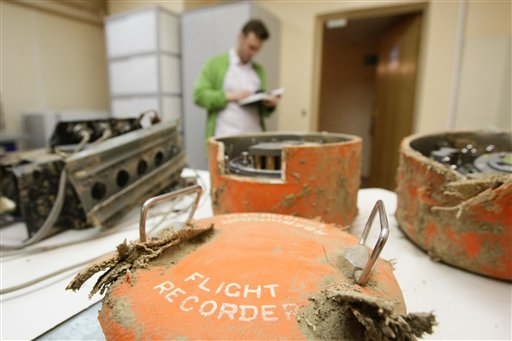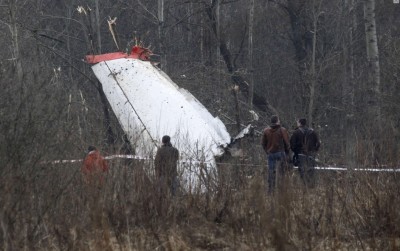 Moscow – As Polish President Lech Kaczynski’s plane streaked toward disaster, at least two passengers visited the cockpit, others may have chatted on cellular phones that can obstruct navigation instruments and an under-trained crew faced heavy fog over challenging terrain.
Moscow – As Polish President Lech Kaczynski’s plane streaked toward disaster, at least two passengers visited the cockpit, others may have chatted on cellular phones that can obstruct navigation instruments and an under-trained crew faced heavy fog over challenging terrain.
Subscribe to our Daily Roundup Email
Those were among the details revealed Wednesday by Russian and Polish officials investigating the April 10 crash that killed Kaczynski, his wife and 94 others outside the western Russian city of Smolensk. The preliminary report drew no conclusions about what caused the catastrophe.
The crash had deep diplomatic resonance given the long-troubled relations between Russia and Poland, and releasing an incomplete report may have been intended by both sides to show their determination to be candid and cooperative.
Alexei Morozov, head of the technical commission of Russia’s Interstate Aviation Committee, also told reporters that among the questions that need further investigation is whether the rolling terrain around the Smolensk military airport distorted instrument readings.
The plane went down in a ravine some 15 meters (50 feet) below the level of the runway just a kilometer away.
“The presence of this ravine can have a natural influence on the readings of the radio altimeter,” he said. “This is one of the subjects the technical commission is working on.”
He also said the commission was probing whether the use of cell phones aboard the Tu-154 affected its navigation.

The most tantalizing, though inconclusive, detail was that two voices not belonging to crew members showed up on the battered cockpit flight recorders. Officials said it’s not clear who one of the voices belonged to, declined to identify the other and didn’t report what either person said.
But the information could feed persistent speculation in Poland that Kaczynski or someone in his entourage pressured the crew to land despite visibility that had shrunk to about 200 meters (660 feet). The plane was carrying top political figures on a mission important to constituents — attending a memorial ceremony for thousands of Polish officers who were killed by Soviet secret police in 1940.
Edmund Klich, Poland’s envoy to the investigation, said only that “certain suggestions” were made by the passengers that he believed had no influence on the plane’s fate, though admitted he had not heard the recordings. The voices were heard no later than 16 minutes before the crash.
Poland’s PAP agency said it learned from a source close to the investigation in Moscow that one of the two voices in the cockpit that did not belong to a crew member was that of the Air Force Commander, Gen. Andrzej Blasik.

Morozov also said the Polish air force crew piloting the plane had been assembled only a few days before the flight and that they had not been receiving regular training that could have helped them cope with unusual conditions.
About five seconds before the plane hit a tree in the ravine, the captain switched off the autpilot and started to bank around for a second landing attempt, Morozov said. An automated voice warned “pull up” about 18 seconds before the crash, and before that the crew twice heard the phrase “terrain ahead,” Morozov said.
The pilot appeared to have ignored warnings of poor visibility and advice to land elsewhere. About 11 minutes before the crash the crew of a Russian plane informed the Polish crew that it had made two attempts to land before changing course for another airport. Seven minutes later the crew of a Polish Defense Ministry plane that had landed in Smolensk 90 minutes earlier informed the presidential plane that visibility had deteriorated.
Changing course would have severely delayed Kaczynski and his delegation from getting to the memorial ceremony.
The officials on Wednesday confirmed earlier reports that the Polish plane, though in service for more than 30 years, was in good condition and had undergone proper inspection. Proper radar facilities were in place at the Smolensk airport, which on April 5 was inspected and found to be fit to accept VIP flights.

the Russian kgb took that plain down we all know it
It is a fact that Polish pilots have a drink “for luck” before taking off.
“The presence of this ravine can have a natural influence on the readings of the radio altimeter,” he said.
For regular flight the crew refers to a barometric altimeter set to the local airport’s current information. (updated hourly.) for high altitude flight the altimeter is set to a standard atmospheric pressure of 29.92″ Hg or 1013.25 mb (millibars). The radio altimeter would probably never be referenced for low altitude flight and the ravine would not effect the barometric altimeter. That said, on final approach the plane would follow the airport’s “glidescope” for correct angle of descent along the center line of the runway. The altimeter would only be a back up instrument once on the glidescope. If you’re 50′ below ground level one mile from the runway, you weren’t using your instruments, or your altimeter was not correctly set to local ATIS. The incident smacks from BIG TIME pilot error.